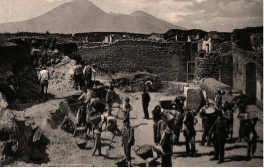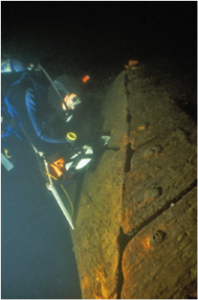On Friday some of my fellow classmates and I went to do fieldwork for my Archaeology class with my professor. We surveyed the land and found some incredibly interesting things without even breaking the surface of the soil. It was a lot more work than I had initially thought. It made me think about those archaeologists who do fieldwork often. They are very dedicated because they have to deal with so many factors in the field. Fieldwork may not sound like a significant amount of work, but it truly is. Especially for the archaeologists who need to spend more than six hours in the field at a time. There are so many challenges to face when working in the field. In addition to mud, bugs, and weather conditions, there are also the unpredictable challenges that technical difficulties pose as well as navigation.
When people think of fieldwork, they imagine archaeologists digging for some sort of lost treasure or buried civilization. Pompeii is a good example of this. Pompeii was first excavated in 1748 after being preserved for over 2,000 years by lava from a volcano that erupted in 79A.D. Almost everything was preserved including buildings, skeletons, and even loaves of bread.

This picture depicts the excavation of Pompeii after the eruption of Vesuvius over 2,000 years prior.
For more information about Pompeii and its excavation, see links below.
http://www.pompeiisites.org/Sezione.jsp?titolo=History+of+the+excavation+of+Pompeii&idSezione=1003
http://www.history.com/topics/pompeii
Although many archaeologists are still fascinated by Pompeii and other similar excavation sites, there are different types of archaeology that do not involve breaking through the surface of the earth. This includes underwater archaeology, which is incredibly difficult in the fieldwork aspect of it. Underwater archaeologists only have a finite amount of air in their tanks when they dive down to their site, at the bottom of the water.

A diver takes a look at the hull of the 1758 Land Tortoise, the oldest known warship of its kind. During this project, the underwater archaeologists had around 16 minutes for each dive so planning was essential.
Underwater archaeology is incredibly difficult and requires great consideration and planning; however, as my classmates and I learned on Friday, so does above ground archaeology. Surveying land does not seem like it needs particularly intense amounts of planning but it truly does. A major aspect of doing fieldwork (especially in the woods) is navigation. My group mostly worked with a compass and a map. We did our best to stay on our path but it was difficult because there were obstacles in the way. The terrain was very hilly and woody. There were some parts of the woods where we needed to go around large and tangled fallen trees and then reorient ourselves. It also takes a great deal of time when you are looking for artifacts and features. When you have an eye for finding these types of archaeological finds, there are usually many things that pop out at you- even a 1980’s beer can will tell you something about the people who used to inhabit that area.
In an age where we are all so interconnected through technology, it is difficult to imagine communication by walkie-talkie’s alone. That is what my classmates and I did on our fieldwork. We split up into three groups (with about three or four people in each) and split up the territory so that we could cover a greater amount of land. At least one person in each group had a walkie-talkie so that we could communicate with each other. However, when the land is hilly and the signal is not that powerful, problems could occur when attempting to contact another group. This happened for a brief period when we were about to eat lunch and we heard nothing from one of the groups. We then all went as a large group to look for our fellow classmates. We used our orientation skills to find their path and then finally were able to get in touch with them. This could also be a major area of stress and difficulty for archaeologists who have found something in the field and want a colleague to check it out.
Although there are many difficulties when doing archaeology fieldwork, it is truly worth it when searching and finding things about the people who lived there. Learning about a past culture helps us understand them better and therefore helps us better understand ourselves. If given the opportunity, I would highly recommend participating in archaeology fieldwork. Without digging a single hole in the ground, I learned so much about archaeological fieldwork and the people who used to live on the land that we were surveying.
Works Cited:
“History of the Excavation of Pompeii.” Pompeii Sites. N.p., n.d. Web. <http://www.pompeiisites.org/Sezione.jsp?titolo=History+of+the+excavation+of+Pompeii&idSezione=1003>.
“Pompeii.” History.com. A&E Television Networks, n.d. Web. 06 Oct. 2013. <http://www.history.com/topics/pompeii>.
Images:
http://www.billiesilvey.com/pompeii_excavation.jpg
http://www.dec.ny.gov/images/administration_images/0210boats5.jpg

Archaeology takes many more forms than popular narratives would have you believe; as you mention here, archaeology can range from underwater research to excavation to survey on foot, which is what your field work group did. In fact, sites like Pompeii can give the public false ideas as to what to expect from a typical site; Pompeii, and sites like it, are extremely rare in that almost everything was left as it was used at the time and the preservation was excellent. While they might not be common, disaster sites like Pompeii can give incredible insight into a specific culture’s lifeways at a fixed moment in time. Some archaeologists are now turning to the aftermath of disasters for study, counting on the fact that people often leave most of all of their belongings behind in a mad rush to escape. The site Chernobyl nuclear event of April 1986, for example, is the subject of recent study for this very reason. Residents were quickly evacuated and given inaccurate information – they were told they would be able to return in three days. In their haste, they were forced to left precious belongings and even their pets behind. Archaeologists like Richard Madden have ventured into the irradiated zone to study their abandoned homes and material objects, which, though sometimes changed by looters or the process of decomposition, are occasionally just as they were left behind and therefore a crucial window into life in the USSR at the time.
To hear more about Madden’s work, watch this webinar: https://connect.sunet.se/p78jb3wuw2g/?launcher=false&fcsContent=true&pbMode=normal